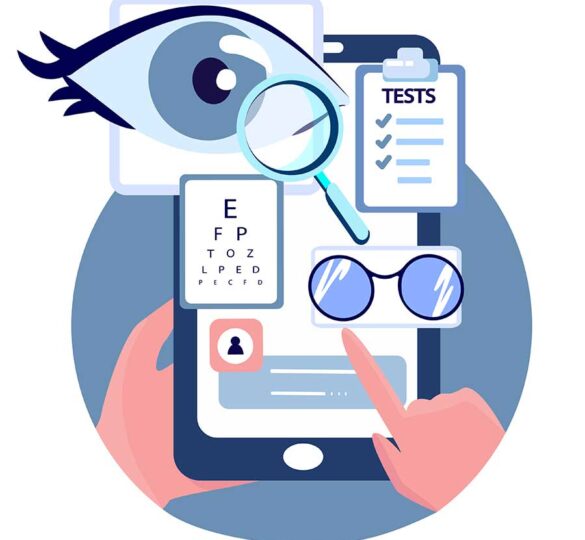Glaucoma Warning Signs
Some people may have early warning signs, but most patients will not notice any vision loss until the disease is at a late stage.

Glaucoma — a group of diseases that affect the optic nerve of the eye — impacts millions of people in the world, but many are unaware they have the disease because often there are no early symptoms.
Some people may have warning signs but most patients will not notice any vision loss until the disease is at a late stage. Although there is currently no cure for glaucoma, there are treatment options to prevent significant vision loss if detected early.
Glaucoma damages the optic nerve, which is the main communication link between the eye and the brain. It is caused by increased pressure in the eye when the normal drainage pathway is more resistant to fluid leaving the eye.
Normally fluid—known as aqueous humor—flows into and exits the eye at a balanced rate, maintaining a healthy pressure within the eye. When there is blockage of the fluid from exiting the eye, the pressure rises, causing damage to the optic nerve. Left untreated, it can eventually lead to vision loss or impairment.
The most reliable and recommended way to find out if you have glaucoma is to get a yearly eye exam to check for vision changes and diseases like glaucoma. The exam for glaucoma is short and painless. Your eye doctor will numb your eyes with drops before measuring your eye pressure with a tool called a tonometer. Be sure to let your doctor know if you’ve had refractive surgery like LASIK, since It can affect your eye pressure reading.
What Are the Signals That I Might Have Glaucoma?
The warning signs can be different depending on the type of glaucoma, and may include the following:
Primary Open-Angle Glaucoma (POAG) Symptoms
It is not unusual for people to forgo their yearly eye exam when they think their eyes are fine. But because POAG typically has no early symptoms, it can be quite a shock to receive a glaucoma diagnosis. That was the situation with Stephanie, who was diagnosed with glaucoma in her early 40s.
With POAG, the drainage angle at the junction of the iris and cornea remains open, but the trabecular meshwork — the eye’s drainage canals — that exists within the angle becomes clogged. When that happens, the pressure starts to increase, leading to optic nerve damage. Since it happens slowly, many people are unaware there’s a problem until they have vision loss, which is a late sign.
Signs of POAG can include:
- Blind spots in your side or peripheral vision — Many people don’t notice this sign because the sharpness of their center vision is maintained until the late stages of the disease.
- Tunnel vision — Some people start to lose vision around the edges of their visual field. Again, this is generally found in advanced stages of the condition.
- Central vision loss — This is generally considered a sign of severe or advanced glaucoma. Parts or most of the central area of vision are blurry.
Primary Angle-Closure Glaucoma Symptoms
Although not as common as POAG, the symptoms of primary angle-closure glaucoma (PACG)–specifically the acute form — can be very noticeable. If you experience any of these warning signs, which are common in the acute form of PACG, you should seek immediate care from an eye doctor.
- Seeing halos around lights — If you see rainbow-colored circles around lights or are unusually sensitive to light, it could be a sign of an acute attack of glaucoma in which the pressure is high and the cornea becomes swollen, causing halos.
- Vision loss — Especially if it happens suddenly.
- Hazy or blurred vision — A cloudy cornea can cause blurry vision.
- Nausea or vomiting — Especially when it accompanies severe eye pain.
- Severe eye and head pain — This often occurs in the acute form of PACG — a result of a very high eye pressure.
Congenital Glaucoma in Infants
Congenital Glaucoma usually shows up in newborns or during a baby’s first few years. Symptoms and signs include:
- Tearing, sensitivity to light, and eyelid spasms
- A larger cornea and clouding of the normally transparent cornea
- Habitual rubbing of the eyes, squinting, or keeping the eyes closed much of the time
Be Aware of the Signs
There is currently no cure for glaucoma. However, regular examinations performed by an eye doctor are critical because the earlier glaucoma is detected, the more effectively it can be treated. In most cases, glaucoma treatments can minimize or prevent vision loss and blindness.
Help Us Find a Cure
The diligent work of researchers continues to lead to a better understanding of glaucoma every day. As a result, there’s great hope for new and improved treatments, including superior drug delivery methods, laser treatments, and less invasive surgical techniques. You can help make that happen!
Every contribution helps bring us closer to finding a cure for glaucoma. Whether you donate cash or stock, create a fundraising event, or even donate a vehicle or boat, your donation will give hope to those living with glaucoma and accelerate our research.
Article reviewed for medical accuracy by Shan Lin, MD. Posted on May 5, 2022

Shan Lin, MD
Shan Lin, MD is a glaucoma specialist at the Glaucoma Center of San Francisco and co-Director of Research at the Glaucoma Research and Education Group. Dr. Lin specializes in glaucoma and cataract surgery. His areas of research include new medications and surgeries for treating glaucoma.